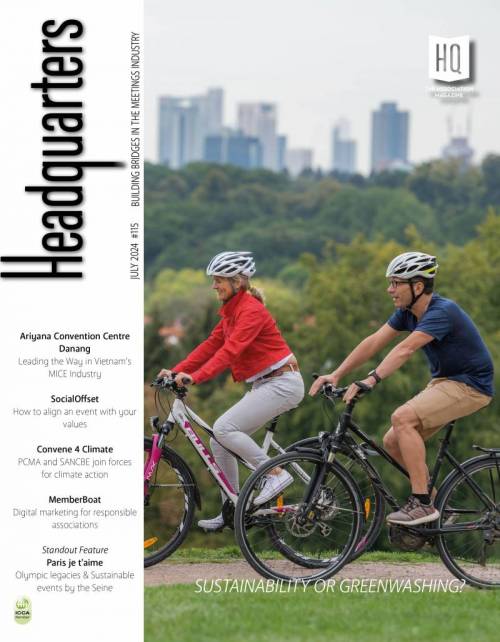How Associations Can Leverage and Optimise Revenue?

In this article, several World PCO Alliance partners share their views on the topic of revenue streams for associations, and some insight on how associations can explore and leverage alternate sources of income.
Managing an association is an involved and complex task, comprised of many elements. One of the most important − if not the most vital − of these is revenue. While an association may have an admirable mission statement and doing a stellar job of engaging with members, the fact is steady and reliable revenue streams are vital for the association’s long-term success. And yet financial struggles are an all-too-common challenge for many organisations.
When examining the most common funding source for an association, event revenue is obviously a staple. Yet, depending too much on an event is dangerous; it does not guarantee stable income and thus can leave associations in precarious and vulnerable financial situations. One of the most critical aspects of any association’s financial health is the cash flow that will fund and enhance an association’s wide range of activities, which in turn will automatically increase its visibility and member benefits. As André Vietor of Bco Congresos states, conference revenue should only represent approximately 20% of an association’s overall income. So, the obvious question is then: what other sources of revenue exist?
Going Local: The Benefits of Local Partnerships for International Meetings
One such source is leveraging educational content, a strategy that blossomed with the pandemic. With events shifting to virtual or hybrid formats, associations increasingly offered scientific/educational content online for a fee. In addition, the hybrid meeting model is not disappearing anytime soon, and virtual participation at conferences has increased over the past few years. Associations have adapted accordingly, selling live or recorded sessions online to those members who, for various reasons, opted to not attend the event in-person. Selling content is definitely an interesting and more common revenue stream for associations.
 Kitty Wong of K&A International points out that, in fact, virtual meetings have increased revenue over 2021 and 2022.
Kitty Wong of K&A International points out that, in fact, virtual meetings have increased revenue over 2021 and 2022.
Another revenue stream with great potential is what Vietor calls “the industry partnership model.” This model calls for associations to move towards industry partnerships rather than solely sponsorship relationships. In doing so, associations can raise institutional − and additional − funds that are not necessarily related to their conferences. Such funds can be in the form of scientific trials, virtual educational platforms, webinars, and on-demand, workshops. In so doing, however, associations want to also avoid the trap of becoming an industry-driven association − that is, an association being driven by industry interests. Associations must remain focused on the professionals in their field − independent and empowered to make decisions without the influence of third parties.
To avoid this pitfall while still giving the industry a voice, Vietor suggests associations set up Industry Advisory Boards. In cases of the absence of such a board, it is vital to conduct industry site meetings for any upcoming events, as well as debrief meetings to solicit industry feedback on their experience and input on how to improve the next conference.
Diversity and Inclusion in the Events Industry
Despite alternative revenue sources available to an association, event sponsorship remains a key priority. The opportunity to interact with professionals in the field is the primary reason that exhibitors and sponsors support a conference in the first place, and Jean-Paul de Lavison from JPdL International urges associations to remember that the depth of their relationships with sponsors are ultimately the catalyst for sponsorship revenues. “Money does not fall from the sky,” says de Lavison. “Rather, it’s a result of common interests and initiatives that are being showcased at the event.”
To optimise sponsorship revenue, the answer is at once simple yet complex: deliver a “wow experience.”
The COVID-19 pandemic and its enormous impact on event attendance has created a big challenge for associations: restoring the number of physical attendees from pre-COVID years. Because this is a hefty task, Vietor says that associations must set the highest standards for themselves. Events have to offer a unique experience for both industry representatives and attendees. We have seen many innovations with this goal in mind, including taking on-site activities out of meeting rooms and placing them close to the exhibition space, gamification and spaces for unique experiences. Vietor also mentions the unexpected social media success at one recent conference where attendees had a piano at their disposal: “Associations must show people that their events simply cannot be missed.”
All in all, associations must be relentless in their pursuit of creative and new sources of revenue while continuing to nurture their relationships with event sponsors. In doing so, associations are assured of long- term viability as well as the industry support that will allow them to continue the advocacy that reinforces their relevance in an ever-changing world.
How Events Can Create a Long-lasting Impact?
Other Articles
About Us
Supported by the Union of International Associations (UIA), the International Association of Professional Congress Organisers (IAPCO) and the Interel Group, the global public affairs and association management consultancy, Headquarters Magazines serve the needs of international associations organising worldwide congresses.















